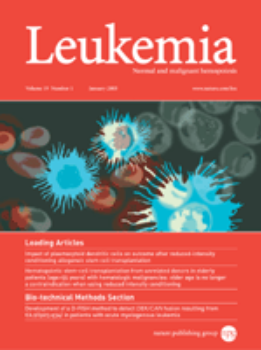慢性淋巴细胞白血病患者携带t的临床和转录组学特征(14;19):一项ERIC研究。
IF 13.4
1区 医学
Q1 HEMATOLOGY
引用次数: 0
摘要
在慢性淋巴细胞白血病(CLL)中,复杂核型(CK)在预后分层中的作用仍然是一个有争议的话题,特异性细胞遗传学异常的影响仍然不清楚。本研究旨在探讨涉及BCL3基因的t(14;19)(q32;q13) (tCLL) CLL的临床和生物学特征。tCLL患者比其他无t的患者更年轻,更常见的表现为未突变的IGHV基因、8亚群定型、12号染色体三体和复杂的核型(14;19)(oCLL)。与oCLL相比,t(14;19)的存在与更短的治疗时间和总生存期相关。基因表达分析揭示了tCLL中独特的转录组谱,其特征是BCL3上调和b细胞受体PI3K-Akt的激活。相反,凋亡相关通路在tCLL中被抑制。BTK基因上调,编码促凋亡蛋白BIM的BCL2L11基因下调。值得注意的是,与以venetoclax为基础(vin为基础)的治疗方案相比,tCLL患者的特征是BTK抑制剂(BTKi)治疗的时间更长(p = 0.058)。我们强调tCLL的不良后果,其独特的分子特征和基因表达模式。因此,我们的数据表明,识别tCLL可以帮助定制治疗方法。本文章由计算机程序翻译,如有差异,请以英文原文为准。
Clinical and transcriptomic characterization of patients with chronic lymphocytic leukemia harboring t(14;19): an ERIC study.
In chronic lymphocytic leukemia (CLL), the role of complex karyotype (CK) for prognostic stratification remains a topic of debate, and the impact of specific cytogenetic abnormalities is still unclear. This study aims to investigate the clinical and biological features of CLL with t(14;19)(q32;q13) (tCLL) involving the BCL3 gene. Patients with tCLL were younger and more commonly presented unmutated IGHV gene, subset #8 stereotypy, trisomy of chromosome 12, and complex karyotype than other patients without t(14;19) (oCLL). The presence of t(14;19) was associated with a shorter time to treatment and overall survival compared to oCLL. Gene expression analysis revealed a unique transcriptome profile in tCLL, characterized by the upregulation of BCL3 and the activation of B-cell receptor, PI3K-Akt. Conversely, apoptosis-related pathways were suppressed in tCLL. While the BTK gene was upregulated, the BCL2L11 gene, coding for the pro-apoptotic protein BIM, was downregulated. Notably, patients with tCLL were characterized by a trend (p = 0.058) for a longer time to the next treatment with BTK inhibitors (BTKi) compared to those treated with a venetoclax-based (Ven-based) regimen. We underscore the adverse outcomes of tCLL, its distinct molecular features and gene expression patterns. Therefore, our data suggest that identifying tCLL could help tailor therapeutic approaches.
求助全文
通过发布文献求助,成功后即可免费获取论文全文。
去求助
来源期刊

Leukemia
医学-血液学
CiteScore
18.10
自引率
3.50%
发文量
270
审稿时长
3-6 weeks
期刊介绍:
Title: Leukemia
Journal Overview:
Publishes high-quality, peer-reviewed research
Covers all aspects of research and treatment of leukemia and allied diseases
Includes studies of normal hemopoiesis due to comparative relevance
Topics of Interest:
Oncogenes
Growth factors
Stem cells
Leukemia genomics
Cell cycle
Signal transduction
Molecular targets for therapy
And more
Content Types:
Original research articles
Reviews
Letters
Correspondence
Comments elaborating on significant advances and covering topical issues
 求助内容:
求助内容: 应助结果提醒方式:
应助结果提醒方式:


